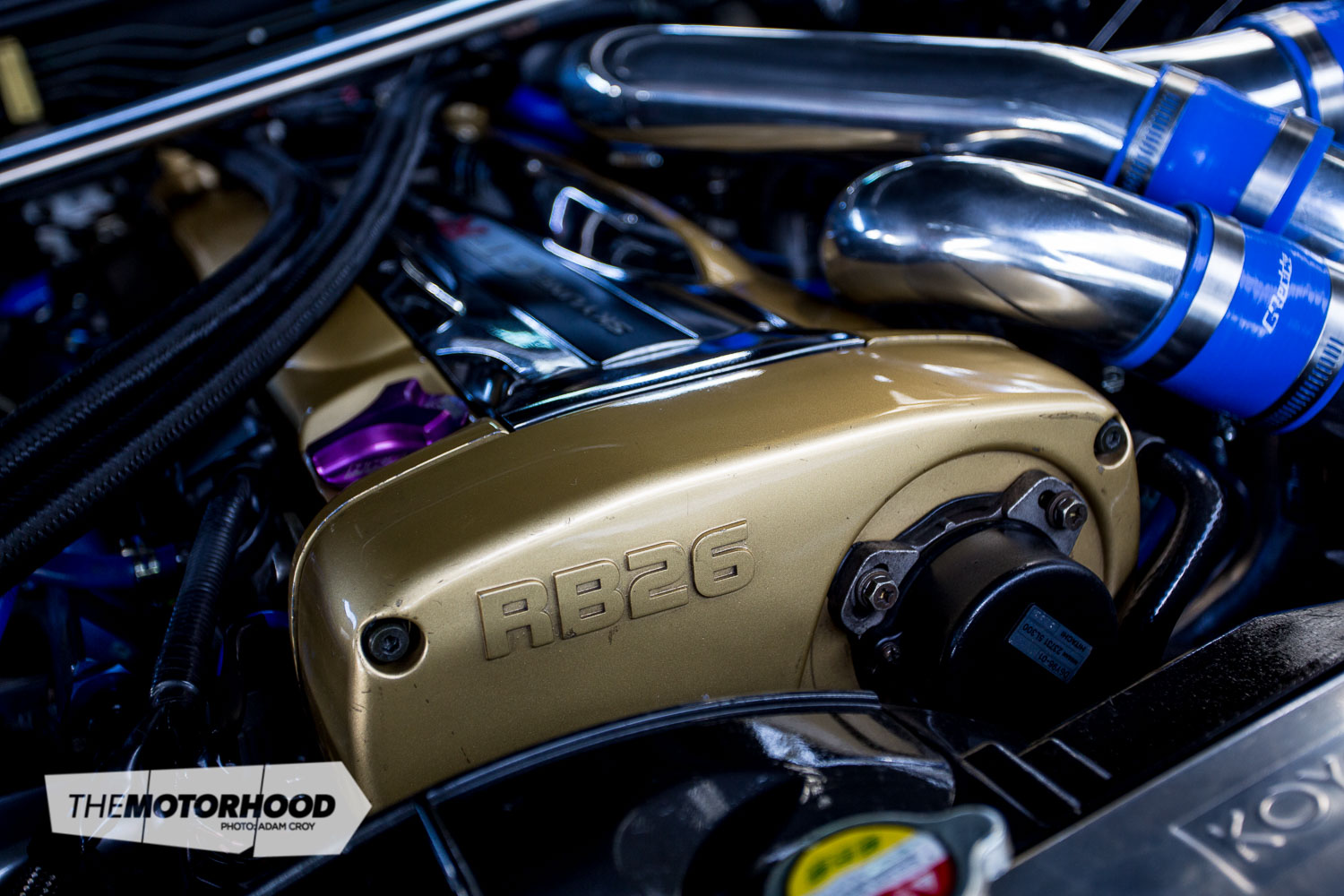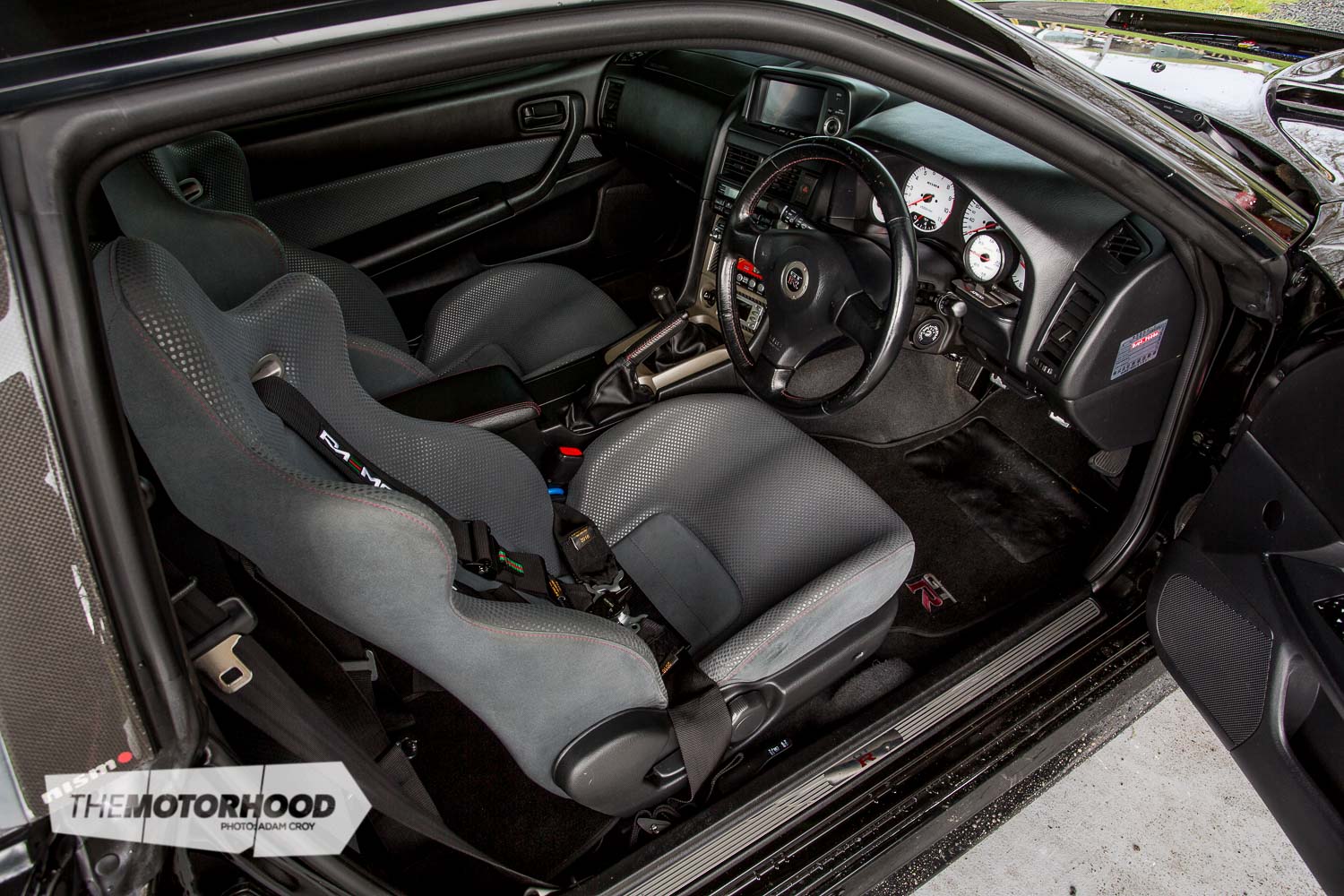data-animation-override>
““It takes three generations for a restaurant to perfect the taste of its dishes” — Kozo Watanabe, founding father of the modern GT-R”
Nissan was close. The BCNR33 project was hugely successful, the chassis was more refined than the R32, and it performed better in every aspect. Nissan knew the R34 had to be the ultimate. The R33 had beaten the R32 around the twisty Nürburgring by 21 seconds, and although the engineers knew their newly developed R34 wouldn’t beat the R33 by the same margin, it was to be quicker under any conditions. Seven seconds quicker around the gruelling circuit — Nissan had built the ultimate production car.

Emil Roshan became a GT-R enthusiast the same way a lot of us did, through motor sport, and is currently on his third. His first, a midnight-purple R33 GT-R V-Spec, was completely factory bar a set of Enkei NT01s, but was unfortunately taken from outside his home in Auckland — a fate plenty of Skyline owners are all too familiar with. Not wanting that to happen again, Emil purchased a pink R33 GT-R in the hope that it would not get stolen. This backfired, as when it came time to sell it there weren’t many who were after such a colour — but eventually the pink body-kitted R33 was sold. “I’ve always wanted an R34 GT-R, and one day I was down at ST-Hitec when I saw this example. The owner was keen to sell it, as he had spent too much on it and was also worried about it getting stolen,” Emil told us.

His build closely resembles the values of Japanese-based tuner Mines, as Emil opted for the ultimate in response. A large single turbo was never on the cards, and neither was ethanol. Instead, a pump gas everyday kind of supercar that could be beaten on at the track and driven home is what he was after. To achieve this goal capacity had to increase, so an N1 block was sourced, along with a swag of Tomei internals, including the elusive and exclusive Tomei 2.8-litre counterweight crank. Tomei cams measuring 280 degrees with a 10.80mm lift combined with a ported head and adjustable Tomei cam gears were installed to give the GT-R the widest powerband possible — the aggressive, lumpy idle was a byproduct.

Response comes thanks to a combination of things. Increasing capacity can bring boost on quicker, improving response, or simply installing more-efficient ball-bearing or even billet turbos can have a similar result. Emil opted for both. The now 2.8-litre block feeds a pair of GTX2863 turbos, which sit on ported factory manifolds. Tomei manifolds were in place, but would crack every track day, so off they came. Originally boost was pushed and sucked through an HKS induction kit, but it was found to limit power levels. A GReddy induction kit — which separates the two compressor outlets until much further down the intake system — was installed, and improved boost response by around 500rpm, and Soichi managed to pick up another 20kW on the dyno.

After riding shotgun in the R34, we can assure you it has almost factory-like boost response, yet yields over twice the factory power output, with 428kW at the wheels on 26psi of boost.
Because the R34 is black, it does a great job of hiding some of its special exterior modifications. The Top Secret carbon-fibre bonnet replaced one the previous owner had installed, which they found to be heavier than the stock item — the new bonnet is so thin, it’s see through. A Nismo front diffuser initiates the perfect under-body aero, and the rear Top Secret diffuser keeps the R34 stable at speed.

The GT-R did have Work Emotion XD9s, however, after installing his 360mm two-piece Biot rotors and caliper spacers, he found they didn’t bolt back up. Braking was then further improved with 350mm 370Z rear rotors and Project Mu 999 brake pads. The 18- by by 10.5-inch Rays Volk Racing CE28RT wheels are shod in Falken FK452s for street use, and Nitto NT01s for track days. After searching locally for these wheels, Emil ended up grabbing a plane ticket to Australia to collect them, to save some coin. As the wheels weighed in at just over his allowed carry-on, Emil dragged them onto the plane, avoiding darting looks.

Emil’s GT-R is the perfect all rounder. It runs on pump fuel, has a DVD player to enjoy on long trips to the numerous Taupo track days he attends with his wife in tow, and features a very trick suspension and brake package. Although not the most powerful GT-R in this GT-R mega feature, it is by far the most refined — just as Kozo Watanabe and his successful GT-R engineers intended.
TUNING MENU
1999 Nissan Skyline GT-R (BNR34)
Engine
Model: RB26DETT, 2600cc, six-cylinder
Block: N1 block, Tomei 2.8-litre counterweight crank, Tomei forged pistons, Tomei forged rods, ARP rod-stud kit, ACL race bearings, Tomei oil pump, Trust sump baffle kit, N1 water pump, Nismo engine mounts
Head: Ported, ARP head-stud kit, Tomei Pro cams (280 degrees, 10.8mm lift), Tomei adjustable cam gears, Tomei type-B valve springs, Tomei bronze valve guides, Nismo 1.2mm metal head gasket, Nitto metal intake and exhaust manifold gaskets, Mines cam baffles
Intake: 100mm ARC high-response intercooler, GReddy induction kit, A’PEXi air filters
Turbos: Twin Garrett GTX2863s
Wastegate: HKS Actuators
BOV: Factory
Fuel: 800cc Sard injectors, Nismo in-tank fuel pump, Nismo fuel-pressure regulator, Tomei fuel rail
Ignition: Splitfire coils
Exhaust: Ported factory manifolds, HPI exhaust dump pipes, Mines front pipes, Amuse Titan R1 titanium exhaust
Cooling: Koyo R series radiator, ARC 65-degree thermostat, Samco hose kit, D1 Spec swirl pot, Trust oil cooler
ECU: HKS F-CON V Pro Gold
Other: Nismo boost sensor, HKS EVC4 boost controller, Autobahn88 heater-hose kit
Driveline
Gearbox: Factory Getrag six-speed
Clutch: Nismo super coppermix twin-plate
Flywheel: Nismo chrome-molybdenum high-carbon-steel lightweight flywheel
Diff: Factory
Support
Struts: Tein adjustable coilovers
Springs: Tein
Brakes: (F) 360mm Biot two-piece rotors, Factory Brembo, Project Mu 999 brake pads (R) 350mm Nissan 370Z rotors, Project Mu 999 brake pads
Shoes
Wheels: 18×10.5-inch (+15) Volk CE28N RT black edition
Tyres: 245/40R18 Falken FK452
Exterior
Paint: Factory
Enhancements: Nismo front diffuser, Nismo side skirts and end caps, Top Secret rear diffuser, Nismo clear side indicators, Top Secret carbon-fibre bonnet
Interior
Seats: Factory
Steering wheel: Factory
Instrumentation: Nismo 320kph gauge cluster
Other: Nismo gear knob
ICE: Alpine seven-inch LCD screen head unit, Alpine 6.5-inch components with tweeters
Performance
Power: 428kW (574hp) at the wheels on 26psi of boost
DRIVER PROFILE
Driver/owner: Emil Roshan
Age: 34
Location: Auckland
Build time: One year
Length of ownership: Three years
Thanks: Thanks to Joe Kyle and the crew, Soichi for spending many hours sourcing parts and tuning the GT-R, AJ at the Glossmaster, Ray and Shaun for helping me out often under the bonnet and at the track, and a special thanks to my partner Jen for putting up with me and my non-stop car-related undertakings


